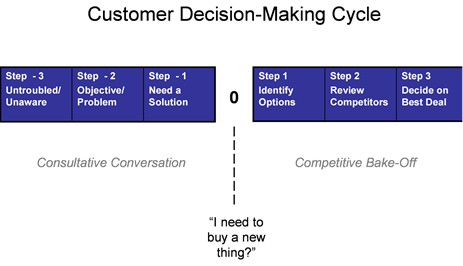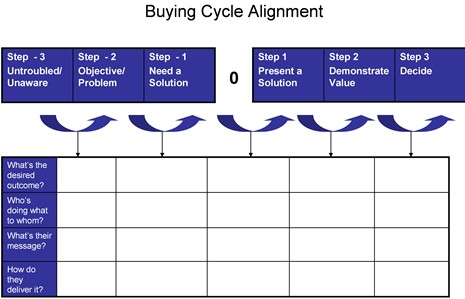Every company I know loathes the so-called competitive bakeoff: That's when customers round up all the leading providers in a given product or service category and make them beat each other. There are few real winners in the competitive bakeoff.
The struggle for marketing and sales teams is to find a way to rise above the competitive bakeoff and have greater impact earlier in the customer buying cycle—where they are still defining their objectives, problems, and needs.
Do your marketing and sales communications perpetuate the head-to-head competitive bakeoff? Or does it equip and enable your sales people to participate earlier and more effectively in the customer buying cycle?
There is an easy way to tell. Take a look at the following graphic.

If most of your marketing and communications start with your products and services and talk about them in more detail, then they are primarily useful in the transactional, competitive bakeoff part of the sales cycle (right side)—where a customer has already identified the category of product or service they need and are simply reviewing competitive options.
Meanwhile, the opportunity for solutions and value-driven selling takes place on the left-hand side of this graphic, where customers are first determining whether they have challenges or problems in meeting their key objectives—and then identifying what needs that creates for possible solutions—even before they ever begin to specify a product or service.
Here lies the biggest opportunity for companies to conduct a consultative conversation. But, more than likely, this is the biggest gap in your marketing messaging, sales tools, and training. Few companies have sufficient content and competency training designed to equip and enable the sales channel to be more proficient in the early part of the customer buying cycle.
Required Changes in Customer Messaging
The conversation with customers changes dramatically between the left- and right-hand side of this graphic. On the right-hand side, the competitive bakeoff, it sounds like this:
- What product are you looking for and what's your budget?
- We've got one of those for about that much.
- Here's what ours does and why it is great.
- And, here's why we're better than the other guys.
- How many do you want?
Perhaps not this trite, but that is essentially the gist of the messaging, tools, and content we build—and, as a result, the types of sales cycles we run.
We have to migrate our customer messaging if we want to play and win on the left-hand side of the equation. We need messaging tools and content that sound something like this:
- What are you looking to accomplish?
- What challenges are you experiencing that keep you from optimal success?
- What if you could do something like this? Is that a possible solution?
- Here's what you can do with us and this will be the result. Will this provide you the value you are looking for?
- Here's proof of others like you achieving the success you desire!
There's a distinct shift from "we" in the first example to "you"—the customer—in the second approach. Unfortunately, most companies' natural drift is toward self, and communicating about themselves, from their perspective, requiring customers to interpret or intuit why that is good for them.
What's required is an approach to creating customer messaging based on the second set of questions. The objective is to establish a consistent approach across the organization for conducting conversations with customers based on what they want to accomplish versus what the company has to sell.
Required Changes in Sales Tools
In addition to changing the focus and tone of the messaging, companies need to review their marketing collateral hierarchies and determine what tools they do or don't have that will encourage and reinforce the desired conversations.
The following figure provides a simple graphic depiction of how we need to consider what might be required to help create conversations and advance the customer buying cycle if we get more involved earlier in the decision-making process.

Establish a cross-functional marketing and sales team to examine the goals, activities and requirements for tools and training to support the left-hand side of the buying cycle. Determine if any of the existing marketing support and sales training tools can be used to engage in these conversations, as well as map out any potential content that would be useful in these key moments of truth.
As a company, you should be able to agree upon and work together to align marketing and sales with the customer buying cycle and create the types of tools and training necessary, if you want to rise above the competitive bakeoff.




